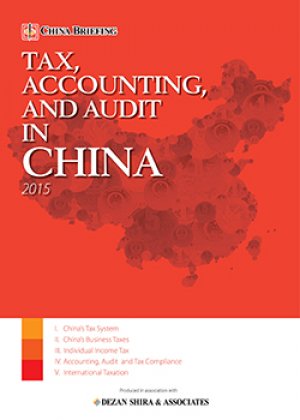China Launches New Preferential Tax Policies for Small Low-Profit Enterprises
By Stephen O’Regan
International Business Advisory, Dezan Shira & Associates
In the past eight years, China has taken a series of measures to aid in the development of small and medium-sized enterprises (SMEs) such as establishing special support funds, reducing corporate income tax (CIT) and value-added tax (VAT) rates, clearing some administrative fees, and allowing special social security policies in certain enterprise. The development of SMEs contributes over 60 percent to China’s total GDP growth and have become a major drive of the country’s economic advancement. These developments are aimed to solve the capital shortage problem that resides in most SMEs and promote more investment and business.
In China, small and low-profit enterprises refer to enterprises engaged in industries which are not prohibited or restricted by the government and meet the following conditions:
- For industrial enterprises with annual taxable income not exceeding RMB 300,000, total employees not exceeding 100 person, and total assets not exceeding RMB 30 million; and
- Other enterprises with annual taxable income not exceeding RMB 300,000, total employees not exceeding 80 person, and total assets not exceeding RMB 10 million.
![]() RELATED: China Announces Preferential Income Tax Policies for Small Businesses
RELATED: China Announces Preferential Income Tax Policies for Small Businesses
China’s State Administration of Taxation recently released the “Announcement on Expanding the Scope of Small Low-profit Enterprises Eligible for CIT Reduced by Half Policy (SAT Announcement [2015] No. 17) and the Cai Shui [2015] No. 34. According to the two documents, all types of small low-profit enterprises that meet the requisite conditions are entitled to the preferential income tax policies.
Small and low-profit enterprises with a taxable income not exceeding RMB 200,000 are allowed to pay corporate income tax at the rate of 20 percent on only 50 percent of their taxable income. Specifically, if a small low-profit enterprise prepays CIT based on its actual profit for the current year, and the accumulative actual profit at the time of making the prepayment is less than RMB 200,000, it is entitled to the Halved Tax Policy; and if such accumulative actual profit exceeds RMB 200,000, the enterprise is no longer entitled to the Halved Tax Policy. If the small low-profit enterprise prepays CIT for the current year based on the quarterly (or monthly) average of the taxable income for the previous year, it is entitled to the Halved Rate Policy.
Such small low-profit enterprises will no longer need to get the approval from tax authorities and they may enjoy the preferential income tax policies at the time of quarterly or monthly prepayment of the CIT. However, for small low-profit enterprise which are subject to tax collection at a fixed amount, the tax authorities will make adjustment to their taxable amount and they need to pay the CIT based on the original measures. Please note that non-resident enterprises which are getting income earned from commercial operations conducted within Chinese territory are not included within the scope of certain tax break policies.
Further, small low-profit enterprises are no longer required to file relevant companies’ information at the time of prepayment and final settlement of corporate income tax. Previously, small low-profit enterprises were required to provide the information about their number of employees and total assets at the time of prepayment declaration.
The preferential policy is effective from January 1, 2015 to December 31, 2017.
|
Asia Briefing Ltd. is a subsidiary of Dezan Shira & Associates. Dezan Shira is a specialist foreign direct investment practice, providing corporate establishment, business advisory, tax advisory and compliance, accounting, payroll, due diligence and financial review services to multinationals investing in China, Hong Kong, India, Vietnam, Singapore and the rest of ASEAN. For further information, please email china@dezshira.com or visit www.dezshira.com. Stay up to date with the latest business and investment trends in Asia by subscribing to our complimentary update service featuring news, commentary and regulatory insight. |
![]()
 Tax, Accounting, and Audit in China 2015
Tax, Accounting, and Audit in China 2015
This edition of Tax, Accounting, and Audit in China, updated for 2015, offers a comprehensive overview of the major taxes foreign investors are likely to encounter when establishing or operating a business in China, as well as other tax-relevant obligations. This concise, detailed, yet pragmatic guide is ideal for CFOs, compliance officers and heads of accounting who must navigate the complex tax and accounting landscape in China in order to effectively manage and strategically plan their China operations.
Managing Your Accounting and Bookkeeping in China
In this issue of China Briefing, we discuss the difference between the International Financial Reporting Standards, and the accounting standards mandated by China’s Ministry of Finance. We also pay special attention to the role of foreign currency in accounting, both in remitting funds, and conversion. In an interview with Jenny Liao, Dezan Shira & Associates’ Senior Manager of Corporate Accounting Services in Shanghai, we outline some of the pros and cons of outsourcing one’s accounting function.
 Adapting Your China WFOE to Service China’s Consumers
Adapting Your China WFOE to Service China’s Consumers
In this issue of China Briefing Magazine, we look at the challenges posed to manufacturers amidst China’s rising labor costs and stricter environmental regulations. Manufacturing WFOEs in China should adapt by expanding their business scope to include distribution and determine suitable supply chain solutions. In this regard, we will take a look at the opportunities in China’s domestic consumer market and forecast the sectors that are set to boom in the coming years.
- Previous Article China to Maintain Current Local Tax Incentives for Foreigners
- Next Article Offshore Status of Hong Kong Companies










